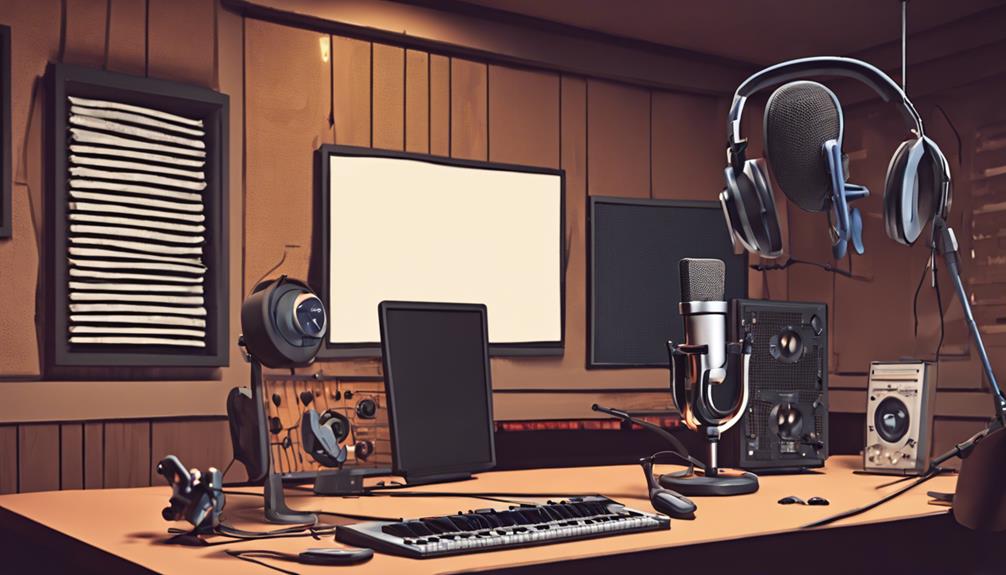3 Tips for Recording Voice Overs for Animation
To bring your animated characters to life, you'll want to master three crucial voice-over recording skills. First, get to know your character inside out by uncovering their motivations, backstory, and personality traits – ask yourself, "What's their biggest fear?" and "What do they want to achieve?" Next, optimize your recording space with sound-absorbing materials and soundproofing to avoid that "cave" effect. Finally, guide the voice actor's performance with clear direction, providing vocal tone cues and constructive feedback. By perfecting these skills, you'll be well on your way to capturing captivating voice-overs that leap off the screen.
Key Takeaways
- Develop a rich understanding of the character's motivations and backstory to bring them to life through voice.
- Optimize the recording space with acoustic treatment and soundproofing materials for high-quality voice-overs.
- Direct the voice actor through clear script interpretation, tone cues, and specific examples to capture the character's personality.
- Create a mental or written history of the character's life to reveal their emotional depth and authenticity.
- Provide constructive feedback that's specific, actionable, and focused on the performance to deliver a captivating performance.
Know Your Character Inside Out
Imagine you're holding a script for a character who's essentially a puzzle – and it's up to you to figure out the intricacies that make them tick.
Developing a rich understanding of your character's motivations and backstory is crucial to bringing them to life through your voice. Start by reading the script and highlighting key moments that reveal their personality, values, and goals.
Ask yourself questions like: What's their biggest fear? What do they want to achieve? What's their sense of humor like?
Delve deeper into their backstory by creating a mental or written history of their life. Where did they grow up? What was their childhood like? What major life events shaped them into the person they're today?
This will help you tap into their emotional depth and authenticity. Remember, your character's motivations should drive their actions and dialogue. By grasping these fundamental aspects, you'll be able to deliver a voice-over performance that's engaging, believable, and true to the character.
Optimize Your Recording Space
A well-designed recording space is your secret sauce to capturing high-quality voice-overs.
You can't just record anywhere, though – a cluttered, echoey space will make your voice sound like it's coming from a cave.
To avoid that, focus on acoustic treatment. This means adding materials that absorb sound, like acoustic panels or DIY solutions like Auralex or Owens Corning 703.
These will help reduce echo and reverberation, making your voice sound crisp and clear.
Soundproofing materials are also essential.
You don't want outside noise sneaking into your recording, and you definitely don't want your neighbors complaining about the loud voices coming from your "secret lair."
Invest in mass-loaded vinyl, soundproofing blankets, or even just add some extra drywall to your walls.
These will help block outside noise and keep your recording space quiet.
By optimizing your recording space, you'll be able to focus on what really matters: bringing your character to life with your voice.
Direct the Voice Over Performance
Direction is the spark that ignites a voice-over performance, turning it from flat and lifeless to dynamic and captivating.
As the director, you have the power to bring the script to life through the voice actor's interpretation. Start by guiding them through script interpretation, ensuring they understand the context, characters, and tone.
Clearly communicate your vision for the character's personality, emotions, and intentions. Provide vocal tone cues to help the voice actor nail the desired tone, whether it's sarcastic, enthusiastic, or mysterious. Give specific examples or references to help them get into character.
Encourage the voice actor to experiment and take risks, but also be clear about what's not working. Offer constructive feedback that's specific, actionable, and focused on the performance, not the person.
By striking the right balance between guidance and freedom, you'll help the voice actor deliver a performance that's authentic, engaging, and memorable. Remember, the goal is to bring the script to life, not just read it.
With your direction, the voice actor will be able to tap into their creative potential and deliver a captivating performance.
Frequently Asked Questions
How Long Does It Take to Record a Voice Over for Animation?
You're wondering how long it takes to record a voice over for animation? Well, it depends on your script preparation and recording pace. Generally, it takes around 2-4 hours to record a 30-minute episode, give or take.
Can I Record Voice Overs on My Smartphone?
You can record voice overs on your smartphone, but will the mobile recording quality be good enough? If you're looking for pro-grade sound, probably not, but for casual use, it's worth a shot, right?
What Software Is Used for Voice Over Editing?
You're editing your voice over – now it's time to geek out on software. Audition and Pro Tools are industry faves for cranking up audio quality and mastering post production techniques to make your voice shine.
Do Voice Over Artists Need Acting Experience?
You might think voice over work's a breeze, but do you need acting chops? While it helps, what's crucial is mastering vocal technique exercises and script interpretation skills – that's where the real magic happens, and you shine.
Can I Record Voice Overs From Home Professionally?
You can totally ditch the fancy studios and record like a pro from home – invest in a solid home studio setup and some serious acoustic treatment, and you'll be sounding like a million bucks.
Conclusion
You've got the character down, the space is optimized, and the director's got a vision – now it's showtime. Remember, a great voice over can make or break an animation, so take these tips to heart. With a character that's on point, a room that's recording-ready, and a director who knows their stuff, you'll be well on your way to bringing your animated world to life.







